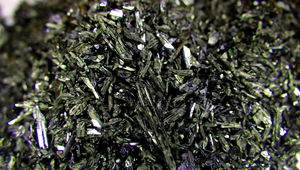Ammonium permanganate
 Ammonium permanganate crystals
| |
| Names | |
|---|---|
| IUPAC name
Ammonium manganate(VII)
| |
| Other names
Azanium permanganate
Permanganic acid, ammonium salt | |
| Properties | |
| NH4MnO4 | |
| Molar mass | 136.974 g/mol |
| Appearance | Violet-brown or dark purple metallic crystals |
| Odor | Odorless (fresh) Nitrogen oxide-like (old) |
| Density | 2.2 g/cm3 (at 20 °C) |
| Melting point | Decomposes violently (detonation) above 60 °C |
| Boiling point | Explodes |
| 8.0 g/100 ml (at 15 °C) 8.57594 g/100 ml (at 25 °C) | |
| Solubility | Insoluble in acetone |
| Thermochemistry | |
| Std enthalpy of
formation (ΔfH |
-703.171 - -686.429 kJ/mol |
| Hazards | |
| Safety data sheet | Chemexper.net |
| Related compounds | |
| Related compounds
|
Permanganic acid |
| Except where otherwise noted, data are given for materials in their standard state (at 25 °C [77 °F], 100 kPa). | |
| Infobox references | |
Ammonium permanganate is an energetic chemical compound with the chemical formula NH4MnO4. It is a strong oxidizer as well as a moderately strong explosive.
Contents
Properties
Chemical
Ammonium permanganate decomposes explosively, releasing nitrogen, water vapors and a copious cloud of dark brownish manganese dioxide dust.[1]
- NH4MnO4 → MnO2 + ½ N2 + H2O
Physical
Ammonium permanganate is a violet-brown or dark purple metallic crystalline or powder, which slowly turns steel-gray over time. Aqueous solutions are magenta–rose in color. It is slightly soluble in water and insoluble in acetone. The density of NH4MnO4 is given different values in literature, with the most recent measurement being 2.2 g/cm3 at 20 °C.[2]
Explosive
Ammonium permanganate is a moderately strong explosive, due to the combination of oxidizer permanganate anion and reducing ammonium cation. Dry ammonium permanganate in sensitive to heat, shock and friction, and may explode at temperatures above 60 °C[3] (110 °C according to Crespi[4]). The detonation of this compound is not extremely violent, and can be done using an open flame, which releases a copious smoke of dark brown powder, as well as projecting leftover material in every direction.[5] Its oxygen balance is zero.
Availability
Ammonium permanganate is not sold by any entities due to its sensitivity and has to be prepared in situ.
Preparation
Ammonium permanganate can be prepared through several ways.
The best involves the reaction of silver permanganate and ammonium chloride in water. Silver chloride precipitates and is removed via filtration. The aqueous ammonium permanganate solution is concentrated by evaporating the water in vacuum and then cooled to precipitate NH4MnO4 crystals.
Potassium permanganate can also be used.[6]
The same process can be used for the reaction of barium permanganate and ammonium sulfate.
Another way is to mix a concentrated solution of ammonium chlorate/perchlorate with another of sodium permanganate. Sodium chlorate/perchlorate will remain in the solution due to its high solubility, while ammonium permanganate will precipitate due to its low solubility in water. The solution is filtered and the precipitate is washed thoroughly to remove any chlorate/perchlorate traces.
A tested method of producing this compound involves dissolving 20 g KMnO4 in 200ml of boiling water, followed by the addition of 250 g ammonium nitrate and stirred until it dissolves. The solution is poured off into another beaker to leave any undissolved or decomposed products in the bottom. Chill the solution to 10 °C to precipitate the NH4MnO4, and remove the solution to collect the reddish-purple crystals. Place the product onto absorbent paper and leave to dry at room temperature. Excess ammonium nitrate must be used, otherwise any leftover potassium permanganate will also precipitate.[7]
Projects
- Make bang snaps
- Make very fine MnO2 powder
Handling
Safety
Ammonium permanganate is corrosive to skin, eyes, mouth and lungs, and contact will stain them brown, casing burns.
Being a strong oxidizer, avoid contact with flammable materials. As it's explosive, proper protection must be worn when handling it. It is sensitive to heat, friction and shock.
Storage
Ammonium permanganate should only be stored for short periods of time, no more than 4 months, in a cool dark place away from light and organic materials and must be used as soon as possible.
Ammonium permanganate decomposes slowly in storage even at room temperatures. A sample stored for 3 months was only 96% pure and after 6 months it assumed color of iodine and had strong smell of nitrogen oxides.[8]
Disposal
Ammonium permanganate can be neutralized by dissolving it in water and adding a reducing agent such as sodium metabisulfite, sodium sulfite, sodium thiosulfate, sulfur dioxide, which converts it into ammonium sulfate and manganese(II) sulfate.
Detonation of NH4MnO4 will give a fine, irritant and corrosive manganese dioxide mist.
References
- ↑ https://www.youtube.com/watch?v=Bh-maHh0nvU
- ↑ Kotai, Laszlo; Argay, Gyula; Holly, Sandor; Keszler, Agnes; Pukanszky, Bela; Banerji, Kalyan K.; Zeitschrift fur Anorganische und Allgemeine Chemie; vol. 627; nb. 1; (2001); p. 114 - 118
- ↑ http://www.textfiles.com/science/CHEMICALS/ammonium_permanganate.txt
- ↑ Crespi, M.; Moles, E.; Anales Soc. Espan. Fis. Quim. (Madrid); vol. 20; (1922); p. 555 - 562
- ↑ https://www.youtube.com/watch?v=go2FLL83Y70
- ↑ https://www.youtube.com/watch?v=zLKmtOTMkHQ
- ↑ http://energetic.proboards.com/thread/47/ammonium-permanganate
- ↑ Seymour M. Kaye (1978), Encyclopedia of Explosives and Related Items, vol. 8